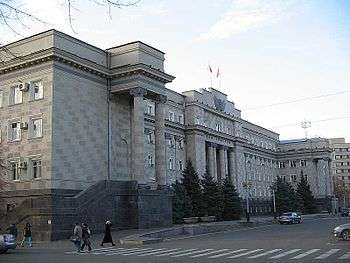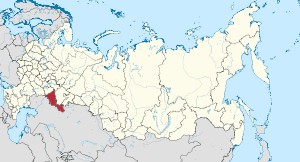Orenburg Oblast
| Orenburg Oblast Оренбургская область (Russian) | |||
|---|---|---|---|
| — Oblast — | |||
| |||
| |||
|
| |||
| Political status | |||
| Country | Russia | ||
| Federal district | Volga[1] | ||
| Economic region | Urals[2] | ||
| Established | December 7, 1934 | ||
| Administrative center | Orenburg | ||
| Government (as of March 2011) | |||
| • Governor | Yury Berg[3] | ||
| • Legislature | Legislative Assembly | ||
| Statistics | |||
| Area (as of the 2002 Census)[4] | |||
| • Total | 124,000 km2 (48,000 sq mi) | ||
| Area rank | 29th | ||
| Population (2010 Census)[5] | |||
| • Total | 2,033,072 | ||
| • Rank | 23rd | ||
| • Density[6] | 16.4/km2 (42/sq mi) | ||
| • Urban | 59.7% | ||
| • Rural | 40.3% | ||
| Time zone(s) | YEKT (UTC+05:00)[7] | ||
| ISO 3166-2 | RU-ORE | ||
| License plates | 56 | ||
| Official languages | Russian[8] | ||
| Official website | |||
Orenburg Oblast (Russian: Оренбу́ргская о́бласть, Orenburgskaya oblast) is a federal subject of Russia (an oblast). Its administrative center is the city of Orenburg. From 1938 to 1957, it bore the name Chkalov Oblast (Чка́ловская о́бласть) in honor of Valery Chkalov. Population: 2,033,072 (2010 Census).[5]

Geography
The most important river of the oblast is the Ural.
Orenburg is traversed by the northeasterly line of equal latitude and longitude.
Administrative divisions
Demographics
Population: 2,033,072 (2010 Census);[5] 2,179,551 (2002 Census);[9] 2,174,459 (1989 Census).[10]
- Vital statistics for 2012
2009 - 1.76 | 2010 - 1.80 | 2011 - 1.80 | 2012 - 1.95 | 2013 - 2.00 | 2014 - 2.03 | 2015 - 2.02(e)
According to the 2010 Census, the ethnic composition of the oblast was as follows:[5]
- Russians: 75.9%
- Tatars: 7.6%
- Kazakhs: 6%
- Ukrainians: 2.5%
- Bashkirs: 2.3%
- Mordvinians: 1.9%
- Germans: 0.6%
- Chuvash: 0.6%
- Belarusians: 0.3%
- Azeris: 0.4%
- other groups, none more than 0.2% of the population
- 30,449 people were registered from administrative databases, and could not declare an ethnicity. It is estimated that the proportion of ethnicities in this group is the same as that of the declared group.[13]
Religion
As of a 2012 official survey[14] 40.2% of the population of Orenburg Oblast adheres to the Russian Orthodox Church, 3% declare themselves to be generic nondenominational Christians (excluding the Protestant definition), 2% are Orthodox Christian believers who do not belong to any church or belong to non-Russian Orthodox churches. Muslims constitute 13% of the population. 3% of the population are followers of the Slavic native faith (Rodnovery), 6.8% are followers of other religions or did not give an answer to the survey. In addition, 20% of the population declares to be "spiritual but not religious" and 12% to be atheist.[14]
Economy
Orenburg Oblast is one of the major agricultural areas of Russia. Its climate is favorable to farming with a humid spring, dry summer and a large number of sunny days, which make perfect conditions for cultivating hard wheat and rye, sunflowers, potatoes, peas, beans, corn, and gourds.
The range of the oblast's export commodities includes: oil and oil products, gas and gas produced products, rolled ferrous and non-ferrous metals, nickel, asbestos, chromium compounds, rough copper, electric engines, radiators, products of machine-building industry.
See also
References
| Wikimedia Commons has media related to Orenburg Oblast. |
- ↑ Президент Российской Федерации. Указ №849 от 13 мая 2000 г. «О полномочном представителе Президента Российской Федерации в федеральном округе». Вступил в силу 13 мая 2000 г. Опубликован: "Собрание законодательства РФ", №20, ст. 2112, 15 мая 2000 г. (President of the Russian Federation. Decree #849 of May 13, 2000 On the Plenipotentiary Representative of the President of the Russian Federation in a Federal District. Effective as of May 13, 2000.).
- ↑ Госстандарт Российской Федерации. №ОК 024-95 27 декабря 1995 г. «Общероссийский классификатор экономических регионов. 2. Экономические районы», в ред. Изменения №5/2001 ОКЭР. (Gosstandart of the Russian Federation. #OK 024-95 December 27, 1995 Russian Classification of Economic Regions. 2. Economic Regions, as amended by the Amendment #5/2001 OKER. ).
- ↑ Official website of Orenburg Oblast. Yury Alexandrovich Berg, Governor of Orenburg Oblast (Russian)
- ↑ Федеральная служба государственной статистики (Federal State Statistics Service) (2004-05-21). "Территория, число районов, населённых пунктов и сельских администраций по субъектам Российской Федерации (Territory, Number of Districts, Inhabited Localities, and Rural Administration by Federal Subjects of the Russian Federation)". Всероссийская перепись населения 2002 года (All-Russia Population Census of 2002) (in Russian). Federal State Statistics Service. Retrieved 2011-11-01.
- 1 2 3 4 Russian Federal State Statistics Service (2011). "Всероссийская перепись населения 2010 года. Том 1" [2010 All-Russian Population Census, vol. 1]. Всероссийская перепись населения 2010 года (2010 All-Russia Population Census) (in Russian). Federal State Statistics Service. Retrieved June 29, 2012.
- ↑ The density value was calculated by dividing the population reported by the 2010 Census by the area shown in the "Area" field. Please note that this value may not be accurate as the area specified in the infobox is not necessarily reported for the same year as the population.
- ↑ Правительство Российской Федерации. Федеральный закон №107-ФЗ от 3 июня 2011 г. «Об исчислении времени», в ред. Федерального закона №271-ФЗ от 03 июля 2016 г. «О внесении изменений в Федеральный закон "Об исчислении времени"». Вступил в силу по истечении шестидесяти дней после дня официального опубликования (6 августа 2011 г.). Опубликован: "Российская газета", №120, 6 июня 2011 г. (Government of the Russian Federation. Federal Law #107-FZ of June 31, 2011 On Calculating Time, as amended by the Federal Law #271-FZ of July 03, 2016 On Amending Federal Law "On Calculating Time". Effective as of after sixty days following the day of the official publication.).
- ↑ Official on the whole territory of Russia according to Article 68.1 of the Constitution of Russia.
- ↑ Russian Federal State Statistics Service (May 21, 2004). "Численность населения России, субъектов Российской Федерации в составе федеральных округов, районов, городских поселений, сельских населённых пунктов – районных центров и сельских населённых пунктов с населением 3 тысячи и более человек" [Population of Russia, Its Federal Districts, Federal Subjects, Districts, Urban Localities, Rural Localities—Administrative Centers, and Rural Localities with Population of Over 3,000] (XLS). Всероссийская перепись населения 2002 года [All-Russia Population Census of 2002] (in Russian). Retrieved August 9, 2014.
- ↑ Demoscope Weekly (1989). "Всесоюзная перепись населения 1989 г. Численность наличного населения союзных и автономных республик, автономных областей и округов, краёв, областей, районов, городских поселений и сёл-райцентров" [All Union Population Census of 1989: Present Population of Union and Autonomous Republics, Autonomous Oblasts and Okrugs, Krais, Oblasts, Districts, Urban Settlements, and Villages Serving as District Administrative Centers]. Всесоюзная перепись населения 1989 года [All-Union Population Census of 1989] (in Russian). Институт демографии Национального исследовательского университета: Высшая школа экономики [Institute of Demography at the National Research University: Higher School of Economics]. Retrieved August 9, 2014.
- ↑ http://www.gks.ru/free_doc/2012/demo/edn12-12.htm
- ↑ http://www.gks.ru/wps/wcm/connect/rosstat_main/rosstat/ru/statistics/publications/catalog/doc_1137674209312
- ↑ http://www.perepis-2010.ru/news/detail.php?ID=6936
- 1 2 3 Arena - Atlas of Religions and Nationalities in Russia. Sreda.org
- ↑ 2012 Survey Maps. "Ogonek", № 34 (5243), 27/08/2012. Retrieved 24-09-2012.
 |
|
 | ||
| |
|
Kostanay Province, | ||
| ||||
| | ||||
| West Kazakhstan Province, |
Aktobe Province, |



